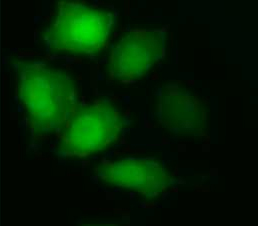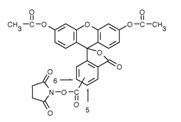CFDA, SE is a fixable-cell-permeant, fluorescein-based tracer for very long-term cell labeling. CFDA, SE passively diffuse into cells and it is nonfluorescent until the acetate groups are cleaved by intracellular esterases to yield the highly fluorescent, amine-reactive fluorophore. Upon reaction with amine-containing residues of intracellular proteins, this probe is well retained in cells.
| Specifications: |

|
|
| Excitation/Emission: | 490/520 (after cleavage) | |
| Shipping Condition: | Ice pack | |
| Storage Conditions: | -20ºC, protect from light | |
| Molecular Formula: | C29H19NO11 | |
| Molecular Weight: | 557.47 | |
| CAS Number: | 150347-59-4 | |

|
||
| Protocol (PDF): | C032 |
| MSDS (PDF): | MSDS-C032 |
| COA (PDF): | C032 |
Reference:
J Immunol 2013; (191):1 164-170
Blood 2013; (121):1 11-19
Nat Immunol (2002) 3:127-127
Frequently Asked Questions (FAQs)
I’m trying to label my cells in suspension and track them over time by labeling with CFDA SE, but after labeling them they will no longer adhere to a surface (whereas unlabeled cells adhere well). I’ve tried to label at 10 and 20 μM. What is causing this?
This dye will bind to proteins via primary amines. Too high of a concentration can lead to cell toxicity or unintended modification of cell function. The solution is to reduce the concentration and/or staining time.
